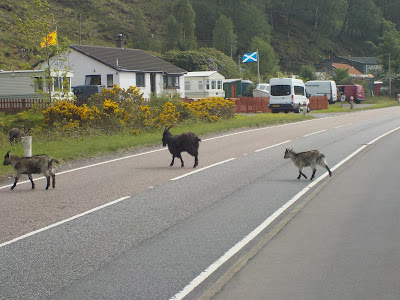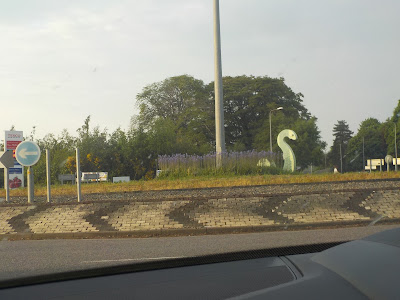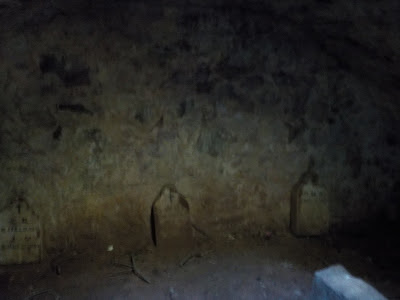The highlight of my trip to Britain in May was a week in Scotland where I managed to get out in full female mode for the first time in years.
I have to thank that witty and informative blogger, Miss Twist, for her inspiration on places to go. If you've not looked at Miss Twist Speaks Her Brains before, I can recommend it for its cosplay antics, psychological insights and girly stances in various beautiful Scottish locations. She made this excellent map with links to her posts describing the various places she's been to and I found it handy for planning my trip. So many thanks to her.
 |
| Twistlike pose at Loch Fleet! |
1: Edinburgh
But let's begin at the beginning with 24 hours in Edinburgh. I was in Edinburgh five years ago and this time I stayed in the 18th-century New Town but spent much of my time in the Old Town, which I haven't visited in thirty years. It's that old that nothing much changes, not even the tourist tat in the shops in the Royal Mile! But it was interesting wandering round again after so long.
I had a curious breakfast the next day, which included Smarties! That's definitely a first.
I also went to the Royal Scottish Academy to see the annual exhibition, some of which was appealing, some not. That's contemporary art, I guess.
And then I took the train through leafy Perthshire and the Cairgorms to Inverness where I was met by Roz who had picked up the car we had hired for our four-day weekend in the Highlands.
At her home, Roz's adorable yet bonkers beaver in denim jacket, kilt and necklace was there to greet me, with a glass of Roz's home-brewed beer (very good it was, too).
2: A monster tour of Loch Ness and beyond
I insisted I wanted above all to go to Loch Ness, which I have never been to before. Monster sightings a bonus, but not essential. It's a lovely spot, about as big as Lake Iseo here in Italy, but wilder with few settlements. This is my best picture of Loch Ness, at the SW end near Fort Augustus. I love the way it looks a bit like a watercolour painting. It was actually taken from the car zooming along!
Although we did an entire circuit of the lake that day, we turned off in several places, heading up Glen Shiel and stopping in the dramatic gorge that marks the 1719 battlefield during the Jacobite Rebellions, which was all part of my school A-level history syllabus a very long time ago. Well, not so long after the event, in fact!
 |
| Click to enlarge |
The Jacobite Uprisings will feature again in this post.
Glen Shiel took us all the way to the west coast at the Kyle of Lochalsh ...
...with its mountain goats ...
...until we got to the famously picturesque Eilean Donan Castle, star of 101 films.
Went went as far as the bridge that now connects the Isle of Skye to the mainland. Our way back brought us to the lumpy landscape of Glen Garry ...
... and the rather nice spot that is the Bridge of Oich on the Caledonian Canal and River Oich.
We took the rougher road that passes south-east of Loch Ness and enjoyed the wide panorama at Suidhe, with its landscape dotted with stone age settlements and its views of lesser lochs, Loch Knockie and Loch Mhor.
The Falls of Foyers, that impressed so many writers of the romantic era, were a little disappointing, but maybe it's not the best time of year. How Roz negotiated the steep climb down in high-heeled sandals, I don't know. But trans women are superwomen!
Boleskine House is near here, home of mystic Aleister Crowley among others, but is currently closed for repairs. It is, apparently, an unusual place ... as you would expect!
We can't leave this tour of Loch Ness without a picture of the monster, can we?
Well, I guess a sculpture on a roundabout in Inverness will have to do as the real monster didn't show up!
We did a lot of miles that day, I've no idea how many. But what a fantastic trip, and in perfect spring weather, too.
3: Cromarty
I also wanted to see Cromarty at the tip of the Black Isle. It's a nice example of a Georgian town; was once the county town of the oddest, most scattered county in the British Isles, Cromartyshire; and was the birthplace of Thomas Urquhart, a hero to linguists such as myself. It's a lovely town, with a very arty feel to it: the arthouse cinema, craft shops and exhibitions, the slaughterhouse repurposed as a coffee shop!...
Despite the offputting name, they do good coffee, and have a cosy fireplace.
The Cromarty Firth is where oil rigs go to die. Here's an atmospheric shot.
The town has reinvented itself as a cultural centre following much emigration. The poignant monument to that emigration stands on the shore looking towards the opening of the Cromarty Firth to the sea and the world beyond.
It was at the Old Courthouse Museum that I enquired more closely about Sir Thomas Urquhart and the custodian went to the library cupboard and brought out copies of just about every book written about him and most of his works. I was stunned, so I took a few notes and will go back one day and look at them properly. Many thanks to the helpful and kind member of staff who showed me the stuff that's not normally on display.
Next door is Hugh Miller's Cottage, with it's pleasant garden, which in turn has a fairy garden!
I insisted we also go and see the so-called pirates' graveyard. So-called not because any known pirates were buried there but because the 17th and 18th-century tombs have a recurring skull and crossbones motif. Here are just a few of the fancier ones.
There's also an unusual and creepy crypt buried right under the turf.
Thankfully, they've put a grille over the open hole that lets a bit of light in. They wouldn't want someone falling in to their own death ... or would they?
Jinkies, Scoob! Sure is creepy! As is the tunnel that was used by servants to get to Cromarty House. You wouldn't want the staff using the main gate along with the Quality now, would you?
Anyway, I thought Cromarty was a fascinating and charming town. The Black Isle peninsula in which it is located is a pleasant farming landscape, and which we drove around to Rosemarkie with its views up and down the Moray Firth and across to Fort George, another testament to the Jacobite Uprisings.
 |
| Moray Firth and Black Isle |
 |
| Vast Fort George, built at great expense between 1748 and 1769, on the opposite shore of the Moray Firth |
We didn't have time to go to Fort George but did enjoy a little time in Fortrose with its ruined cathedral.
That was a very interesting day in lovely, lesser-known places. We finished up at the award-winning Fyrish Tandoor in Alness. Indian restaurants are almost unknown in Italy so I make the most of the opportunities when I'm in Britain. My sizzling lamb shashlik was very good, I have to say.
4: Culloden
I end this part of the trip with our day at Culloden Battlefield where the Jacobites met their final end after 60 years of sporadic civil war. It's complex history and if you really want to delve into it, here's the Wikipedia entry on Jacobitism, or you could go to the outstanding visitor centre on Drummossie Moor east of Inverness, as we did.
Roz knows one of the guides, Iona, and we booked her tour of the battlefield. The National Trust for Scotland owns about half the battlefield and has marked the opposing lines carefully with flags and information boards, and they are allowing the ground to revert from farmland back to bog, which was instrumental in the failure of the Jacobite charge on that fateful day in 1746.
The opposing lines at the start of the battle are clearly marked with paths and red flags for the government forces ...
... and blue flags for the Jacobite forces ...
As museum battlefields go, this is very well marked out and anyone can follow the action, and the aftermath.
I recommend it as a place to visit. The attached museum with documents and artifacts is very good, the café is nice and there is a huge car park. Iona, our guide, was super well-infomed, too.
 |
| Get this lady to guide you if you can. |
I guess I've always had Jacobite sympathies. I'm not so convinced by all these Germans who've been on the British throne for 300 years. Or did the trouble start with the Normans? Or maybe the Danes? Mind you, the Romans really carved things up... Still, we visit historic sites so that we can see ...how the world constantly fails to learn the lessons of history.
So Loch Ness, Cromarty and Culloden were three things to tick off my bucket list. Rather than extending this post with my final full day with Roz, I'll use the next post to describe in more detail the trip to the far north that I took fully en femme, my first Sue outing in six years.
Thanks for reading.
Sue x






























That sounds like a fun trip with lots of interesting places to visit.
ReplyDeleteSmarties with breakfast coffee is definitely a new one.
Boleskine House, I believe, was later bought by Led Zep guitarist Jimmy Page, who was fascinated by all things occult, and particularly by Aleister Crowley and the Golden Dawn.
Urquhart sounds a fascinating character as well. Writer, translator, mathematician, insurgent and rebel, who seems to have spent as much time in captivity as out. I wonder if the bit in Wiki is true that he died of a laughing fit on hearing of the Restoration of Charles II?
Hi Susie, thanks for your comments.
DeleteYes, Jimmy Page was a later owner of Boleskine House. You'll be more up on him than I am. The house has suffered a number if fires and there is a trust that is restoring it, I think to the days of Crowley.
Apparently, it's quite hard actually to die laughing (although it's claimed that two Americans did while watching the movie Airplane). We'll assume he had some other condition that brought on his demise at that moment. I admire him for his translation of Rabelais that remains an example to all of how to translate in a way that captures the intent and spirit of the original author.
I've just posted the final episode of my holiday, when I went fully femme.
Sue x
This comment has been removed by the author.
ReplyDeleteWow, you certainly covered a lot of ground and ticked off the attractions, Sue. I hope you had a lovely time as your writing hints at. It also brought up some happy childhood holiday memories too, so thank you.
ReplyDeleteCulloden as a visitor site has really changed over the years - and for the better too, IMO. I remember wandering around it in the 80s, and it seemed just a few mud paths, maybe a post to show where something or some people had been. Skip on a few years and it was so much better, with information panels, proper paths, and you could start to get a feel for where the forces had faced off.
Did you see any wild Haggis, though? 😉
Neither wild haggis, nor Loch Ness monsters. I think the Scottish Tourist Authority can be a wee bit cheeky at times!
DeleteThey've obviously made a lot of investment in the Culloden site. I got a hint that they will try to buy the rest of the battlefield if the remainder is ever for sale.
It was a very lovely time and I'm glad to hear it brought back good memories for you.
Sue x